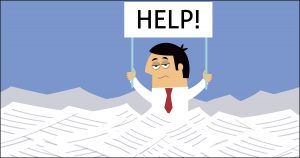Wait! Don’t curse me out! You can have an empty inbox too.
This is the first in a series of posts related to managing email effectively: controlling it, rather than letting it control you.
Become a Patron of Ask Leo! and go ad-free!
“Doing” email
Many years ago, while working at Microsoft, my manager commented to me that he spent too much time “doing email”. Even then, circa 1992, before spam and viruses and email marketing, email had become an important part of daily business. It was easy to feel overwhelmed by the flood of messages, all seeming to demand some kind of response.
But … what does it mean to “do email”?
In my opinion, it means we’re not looking at email properly; it means a fundamental shift in attitude and approach is required.
Email isn’t something you “do,” it’s a tool you use. A powerful tool, to be sure, but just a tool: nothing more, nothing less.
 Given how important a tool it is, I want you to consider honing your skills. Just like a carpenter builds better homes as he becomes more proficient using the tools of his trade, we can all become better at whatever we do by learning to use the tool that is email more effectively and efficiently.
Given how important a tool it is, I want you to consider honing your skills. Just like a carpenter builds better homes as he becomes more proficient using the tools of his trade, we can all become better at whatever we do by learning to use the tool that is email more effectively and efficiently.
And what a powerful tool it is.
Let’s look a little more closely at the difference between “doing email” and using email as a tool.
The job
When my former manager went to work in the morning, his job wasn’t to “do email”. In fact, his job was to manage a group of software engineers and designers who were in the process of producing a particular component of a large software project. Email was simply a tool to facilitate communication between team members, other teams, and other parties interested in the project.
The problem was that the amount of communication happening by email was large – so large, it was easy to feel like email had become the job.
Of course, above and beyond the project, email was being used to participate in mailing lists and on-line discussions, stay in touch with friends and family, and otherwise communicate in both work and non-work-related ways.
One of the very things that makes email so powerful – the ability to deal with it at the times you choose – was being lost in the desire to stay ahead of the incoming tide.
Changing the mindset
The very first step to improving how you deal with email is to be aware what you use email for. Think of all the roles you play, and all the ways in which you use email to carry out those roles.
- Communication with your family and friends
- Receiving direction from a superior, a client, or advisors
- Coordination with co-workers on a project
- Evaluation or management of employees
- Participation in educational, professional, or social discussion groups
- Customer
- Retailer or supplier
- … and many more
Those are just some examples; your list will most certainly be different. In fact, your list may be very open ended and ill defined. That’s ok! The important thing is to start becoming aware of all the distinct ways you use email. Rather than lumping them all into one bucket – “doing email” – we’ll examine ways of dealing with the influx in a more structured, simpler, and hopefully less stressful manner.
Taming the beast: the empty inbox
Yes, as I type this, my inbox is empty. Zero. Nada. There are no messages in it. And I get hundreds of emails every day.
How is it possible to have an empty inbox?
Well, I can tell you one thing I did not do. I did not spend today dealing with it. In fact, I typically avoid email (and social media) during the morning – my most productive time of day. Instead, I’ve been busy with Ask Leo! and various other projects.
I have tools and techniques in place that allow me to sort, filter, ignore, postpone, delete, and prioritize my incoming email. Much of it is automated. In fact, being the kind of person I am, I’ve automated as much of it as possible.
That’s what this series of articles will explore: the tools, techniques, and – perhaps most importantly – the ways of thinking about email that will allow you to be more productive.
Rather than whacking away at wood with a rusty saw, you, too, can become an email craftsman.
Do this
Subscribe to Confident Computing! Less frustration and more confidence, solutions, answers, and tips in your inbox every week.
I'll see you there!
Podcast audio
The “Taming Email” series of articles is based on a project I originally started back in 2006. Now, well over a decade later, the topic is still critically relevant, particularly in the workplace.


For anyone wanting some background reading around this subject, I would recommend ‘Getting Things Done’ by David Allen. Easy to read, but more difficult to put into practice.
Is the series of email articles still available?
Yes. You can find that here: http://tamingemail.com/
It’s old, and out of date, but it’s slowly being updated and migrated here from http://tamingemail.com